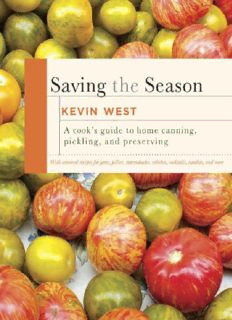
Saving the Season: A Cook's Guide to Home Canning, Pickling, and Preserving PDF
Preview Saving the Season: A Cook's Guide to Home Canning, Pickling, and Preserving
THIS IS A BORZOI BOOK PUBLISHED BY ALFRED A. KNOPF Copyright © 2013 by Kevin West All rights reserved. Published in the United States by Alfred A. Knopf, a division of Random House, Inc., New York, and in Canada by Random House of Canada Limited, Toronto. www.aaknopf.com Knopf, Borzoi Books, and the colophon are registered trademarks of Random House, Inc. All photographs are by the author with the exception of the following: DI01 and DI02 copyright © Ditte Isager. Leek Prize Taker, from The Plant Kingdoms of Charles Jones by Sean Sexton and Robert Flynn Johnson. Reprinted by permission of Thames & Hudson, Ltd., London. The painting on this page is titled Blackberries by Raphaelle Peale. Reprinted courtesy of the Fine Arts Museums of San Francisco. Gift of Mr. and Mrs. John D. Rockefeller III. Additional acknowledgments for permission to reprint previously published material may be found at the end of the volume. LIBRARY OF CONGRESS CATALOGING-IN-PUBLICATION DATA West, Kevin, 1970– Saving the season : a cook’s guide to home canning, pickling, and preserving / by Kevin West.—First edition. pages | | cm Includes bibliographical references and index. eBook ISBN: 978-0-307-95768-9 Hardcover ISBN: 978-0-307-59948-3 1. Canning and preserving. | I. Title. TX601.W47 2013 641.4′2—dc23 2012037844 Cover photographs © Kevin West Cover design by Carol Devine Carson Illustrations © Nicola Atkinson v3.1 FOR GRAN AND PAPA MARY ELOISE WEST [ 1916–1981 ] JOHN R. WEST [ 1912–1999 ] O greatly fortunate farmers, if only they knew How lucky they are! Far from the battlefield, Earth brings forth from herself in ample justice The simple means of life, simply enjoyed. —V ’ “ ” IRGIL S SECOND GEORGIC, TRANSLATED BY DAVID FERRY CONTENTS PREFACE INTRODUCTION SPRING SUMMER FALL WINTER APPENDIX I: SOME POPULAR FRUIT VARIETIES APPENDIX II: PEAK SEASONS BY REGION APPENDIX III: COMPARATIVE pH RANGES OF SOME COMMON FOODS ACKNOWLEDGMENTS BIBLIOGRAPHY INDEX PREFACE THIS IS A BOOK ABOUT PRESERVING and home canning—or “putting up,” as one might say where I’m from—and it will cover jam, jelly, marmalade and other sweet preserves; pickles and briny things; canned tomatoes; liqueurs; candies; and the complement of condiments that includes relishes, sauces, and salsas. Why bother preserving? So that you can eat your efforts later, of course, and give them to other people to eat, too. I do it to save the season. Putting up used to be how plenty prepared for want. Foodstuffs were processed in a season of abundance—when the wild blackberries came in, when hogs were slaughtered at the first cold snap—and brought out to eat in some later time of scarcity. Today we don’t suffer the winter hunger known for most of human history, because the grocery store is always stocked. Not that long ago, though, it was the agricultural cycle—nature—that determined what was on the table, and lusty eaters had to anticipate the harvest of each month, when gardens, orchards, fields, woods, rivers, oceans, and skies delivered a copious annual bounty of a particular thing at a particular time. We’ve forgotten today to wait for seasonal delicacies, and as a punishment the grocery store has become a year-round warehouse of indifferent fruit and vegetable staples, some of which are absurdly imported from the ends of the earth. Just a generation ago—that is to say, when I was little—strawberries were a cause for celebration in the spring. My mother and I made annual trips to a pick- your-own farm, where we were always amazed by how good the strawberries were and by how quickly we could pick more than we could eat. In August we visited my West grandparents, Gran and Papa, and when we returned to South Carolina from their farm in Blount County, Tennessee, my mother’s baby-blue VW Bug would be loaded literally to the roof with bags of corn, buckets of okra and squash, watermelons, and flats of Papa’s homegrown tomatoes. “There’s only two things that money can’t buy,” Papa would say. “That’s true, true love and homegrown tomatoes.” When Gran put them up in quart Mason jars, Papa’s tomatoes were as good in January as they had been in August. That’s what I mean by saving the season.
Description: